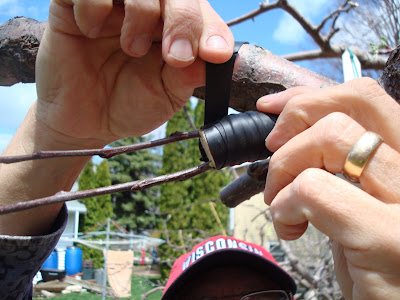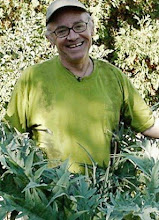 Cardoons are great plants
Cardoons are great plants Cleft grafting on apple - think about this for next spring.
Cleft grafting on apple - think about this for next spring.It may say fall on the calendar but the seed catalogs have already started to arrive. This year by November 16th I had two! - Stokes again was here first but PineTree was in the mailbox too. So November catalogs mean the countdown till the 2011 planting season has begun -"Boy Howdy!" I can hardly wait.
I got to teach a class in plant grafting at Fox Valley Technical College last weekend and I was really excited about the enthusiasm of the class I had. We discussed hard wood grafting and did some practice scion cutting and cleft grafting. I brought apple watersprouts for the practice. Now would be a good time to think about grafting some different apple varieties on that apple tree in the back yard. You would have time to research your choices, learn about grafting and maybe find a class to sign up for that would make your spring grafting experiment successful. Grafting is also a way to renew a tree or save an old favorite apple from another tree onto a branch in your back yard. you can go to the May 6th, 2009 blog entries to see the grafts I put on that season. This season I did not graft any new varieties onto the trees but I think next spring I will be back at it.
We also discussed vegetable grafting and tomatoes were part of that the topic. I think that this grafting is a bit more difficult than hardwood work, but still, as a way to experiment, I find tomato grafting a real challenge. This is the activity I would like to find a class in so I will be checking the Extension sites of both Missouri and North Carolina to see what they might have as classwork next season. Both have done such classes in the past and the North Carolina site has good information about the process. This too might be good winter reading and then you can plan to try tomato grafting next season along with your apple grafting.
The garden is still producing fresh produce. Today I harvested Daikon radishes, Napa cabbage, and Cardoons. Cardoons are on the menu tonight - AuGratin style; however, the Internet shows them as a crispy fried treat too. I harvested three heads that had been tied up for blanching for several weeks. I cleaned the stalks, scraped and pulled off the tough parts and thorns, and put them in lemon water and then blanched them. I am cooking them casserole style with onions, garlic, thyme and cheese but there are many good recipes on the net -Google 'cardoon recipes' and look at the images too. This is a great vegetable and a beautiful garden plant. Here in Wisconsin they are usually an annual but with some protection I have had some return to make seed heads the second year. We also ate these immature flower buds just like artichokes which are a close relative of cardoons. Several seed catalogs have the seed - put them on the wish list for next season.
The pictures this week show some of the hoop house and cold frame plants that will hopefully survive the winter for harvest next spring. The Napa cabbage was ravaged again by the slugs but a little salt in the cleaning water and they are done for - no escargot in the salad please. As you note we are back to alternate weeks with posts during this slow growing time but with the seed catalogs arriving the thoughts of next seasons garden slowly takes form and the excitement of another growing season builds.
Happy Gardening
